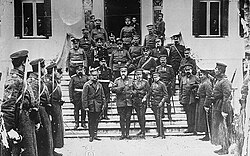
Back أزمة يوليو Arabic Ліпеньскі крызіс Byelorussian জুলাই সঙ্কট Bengali/Bangla Crisi de juliol Catalan Červencová krize Czech Julikrise German Crisis de julio Spanish Juulikriis Estonian Uztaileko krisialdia Basque بحران ژوئیه Persian

| Events leading to World War I |
|---|
 |
|
The July Crisis[b] was a series of interrelated diplomatic and military escalations among the major powers of Europe in the summer of 1914, which led to the outbreak of World War I. The crisis began on 28 June 1914, when Gavrilo Princip, a Bosnian Serb nationalist, assassinated Archduke Franz Ferdinand, heir presumptive to the Austro-Hungarian throne, and his wife Sophie, Duchess of Hohenberg. A complex web of alliances, coupled with the miscalculations of numerous political and military leaders (who either regarded war as in their best interests, or felt that a general war would not occur), resulted in an outbreak of hostilities amongst most of the major European states by early August 1914.
Following the murder, Austria-Hungary sought to inflict a military blow on Serbia, to demonstrate its own strength and to dampen Serbian support for Yugoslav nationalism, viewing it as a threat to the unity of its multi-national empire. However, Vienna, wary of the reaction of Russia (a major supporter of Serbia), sought a guarantee from its ally, Germany, that Berlin would support Austria in any conflict. Germany guaranteed its support through what came to be known as the "blank cheque",[c] but urged Austria-Hungary to attack quickly to localise the war and avoid drawing in Russia. However, Austro-Hungarian leaders would deliberate into mid-July before deciding to give Serbia a harsh ultimatum, and would not attack without a full mobilisation of the army. In the meantime, France met with Russia, reaffirmed their alliance, and agreed they would support Serbia against Austria-Hungary in the event of a war.
Austria-Hungary made its ultimatum to Serbia on 23 July; before Serbia replied, Russia ordered a secret, but noticed, partial mobilisation of its armed forces. Though Russia's military leadership knew they were not yet strong enough for a general war, they believed that the Austro-Hungarian grievance against Serbia was a pretext orchestrated by Germany, and considered a forceful response to be the best course of action. Russia’s partial mobilisation—the first major military action not undertaken by a direct participant in the conflict between Austria-Hungary and Serbia—increased the willingness of Serbia to defy the threat of an Austro-Hungarian attack; it also alarmed the German leadership, having not anticipated the idea of needing to fight Russia before France.[d]
While the United Kingdom was semi-formally aligned with Russia and France, many British leaders saw no compelling reason to get involved militarily; the UK made repeated offers to mediate, and Germany made various promises to try to ensure British neutrality. However, fearing the possibility of Germany overrunning France, Britain entered the war against them on 4 August, and used the German invasion of Belgium to galvanise popular support. By early August, the ostensible reason for armed conflict—the assassination of an Austro-Hungarian archduke—had already become a side-note to a larger European war.
Cite error: There are <ref group=lower-alpha> tags or {{efn}} templates on this page, but the references will not show without a {{reflist|group=lower-alpha}} template or {{notelist}} template (see the help page).
- ^ Van Evera, Stephen (Summer 1984). "The Cult of the Offensive and the Origins of the First World War". International Security. 9 (1): 80–82. doi:10.2307/2538636. JSTOR 2538636.